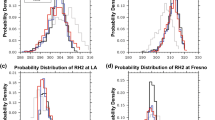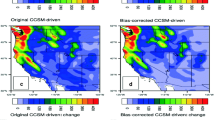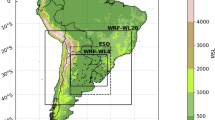Abstract
This study presents a method to incorporate uncertainty of climate variables in climate change impact assessments, where the uncertainty being considered refers to the divergence of general circulation model (GCM) projections. The framework assesses how much bias occurs when the uncertainties of climate variables are ignored. The proposed method is based on the second-order expansion of Taylor series, called second-order approximation (SOA). SOA addresses the bias which occurs by assuming the expected value of a function is equal to the function of the expected value of the predictors. This assumption is not valid for nonlinear systems, such as in the case of the relationship of climate variables to streamflow. To investigate the value of SOA in the climate change context, statistical downscaling models for monthly streamflow were set up for six hydrologic reference stations in Australia which cover contrasting hydro-climate regions. It is shown that in all locations SOA makes the largest difference for low flows and changes the overall mean flow by 1–3%. Another advantage of the SOA approach is that the individual contribution of each climate variable to the total difference can be estimated. It is found that geopotential height and specific humidity cause more bias than wind speeds in the downscaling models considered here.




Similar content being viewed by others
References
Alvarez-Garreton C, Ryu D, Western A, Crow W, Robertson D (2014) The impacts of assimilating satellite soil moisture into a rainfall–runoff model in a semi-arid catchment. J Hydrol 519:2763–2774
Alvisi S, Franchini M (2010) Pipe roughness calibration in water distribution systems using grey numbers. J Hydroinf 12:424. doi:10.2166/hydro.2010.089
Benjamin J, Cornell C (1970) Reliability, statistics and decision for civil engineers. McGraw Hill, New York
Bobba AG, Singh VP, Bengtsson L (1996) Application of first-order and Monte Carlo analysis in watershed water quality models. Water Resour Manag 10:219–240
Cawley GC, Talbot NL (2007) Preventing over-fitting during model selection via Bayesian regularisation of the hyper-parameters. J Mach Learn Res 8:841–861
Cawley GC, Talbot NL (2010) On over-fitting in model selection and subsequent selection bias in performance evaluation. J Mach Learn Res 11:2079–2107
Chen S-T, Yu P-S, Tang Y-H (2010) Statistical downscaling of daily precipitation using support vector machines and multivariate analysis. J Hydrol 385:13–22. doi:10.1016/j.jhydrol.2010.01.021
Chen H, Xu C-Y, Guo S (2012) Comparison and evaluation of multiple GCMs, statistical downscaling and hydrological models in the study of climate change impacts on runoff. J Hydrol 434-435:36–45. doi:10.1016/j.jhydrol.2012.02.040
Cox P, Stephenson D (2007) A changing climate for prediction. Science 317:207–208. doi:10.1126/science.1145956
Dettinger MD, Wilson JL (1981) First order analysis of uncertainty in numerical models of groundwater flow part: 1. Mathematical development. Water Resour Res 17:149–161
Eghdamirad S, Johnson F, Woldemeskel F, Sharma A (2016) Quantifying the sources of uncertainty in upper air climate variables. Journal of Geophysical Research: Atmospheres. doi:10.1002/2015jd024341
Ferrante M, Yeh T-CJ (1999) Head and flux variability in heterogeneous unsaturated soils under transient flow conditions. Water Resour Res 35:1471–1479
Ferrante M, Brunone B, Yeh TCJ (2002) Uncertainty analysis of transient unsaturated flow in bounded domain. Water Resour Res 38:61–66. doi:10.1029/2001wr001015
Fowler HJ, Blenkinsop S, Tebaldi C (2007) Linking climate change modelling to impacts studies: recent advances in downscaling techniques for hydrological modelling. Int J Climatol 27:1547–1578. doi:10.1002/joc.1556
Ghosh S, Mujumdar PP (2008) Statistical downscaling of GCM simulations to streamflow using relevance vector machine. Adv Water Resour 31:132–146. doi:10.1016/j.advwatres.2007.07.005
Glasgow HS, Fortney MD, Lee J, Graettinger AJ, Reeves HW (2003) MODFLOW 2000 head uncertainty, a first-order second moment method. Ground Water 41:342–350
Gold C, Sollich P (2003) Model selection for support vector machine classification. Neurocomputing 55:221–249. doi:10.1016/s0925-2312(03)00375-8
Haan CT (2002) Statistical methods in hydrology, 2nd edn. Iowa State Press, Ames, Iowa
Han E, Merwade V, Heathman GC (2012) Implementation of surface soil moisture data assimilation with watershed scale distributed hydrological model. J Hydrol 416:98–117
Hawkins E (2011) Our evolving climate: communicating the effects of climate variability. Weather 66:175–179
Hawkins E, Sutton R (2009) The potential to narrow uncertainty in regional climate predictions. Bull Am Meteorol Soc 90:1095–1107. doi:10.1175/2009bams2607.1
Hawkins E, Sutton R (2011) The potential to narrow uncertainty in projections of regional precipitation change. Clim Dyn 37:407–418
Johnson F, Sharma A (2012) A nesting model for bias correction of variability at multiple time scales in general circulation model precipitation simulations. Water Resour Res 48:W01504. doi:10.1029/2011wr010464
Johnson F, Sharma A (2015) What are the impacts of bias correction on future drought projections? J Hydrol 525:472–485. doi:10.1016/j.jhydrol.2015.04.002
Joshi D, St-Hilaire A, Daigle A, Ouarda TBMJ (2013) Databased comparison of sparse Bayesian learning and multiple linear regression for statistical downscaling of low flow indices. J Hydrol 488:136–149. doi:10.1016/j.jhydrol.2013.02.040
Karamouz M, Noori N, Moridi A, Ahmadi A (2011) Evaluation of floodplain variability considering impacts of climate change. Hydrol Process 25:90–103. doi:10.1002/hyp.7822
Knutti R et al (2008) A review of uncertainties in global temperature projections over the twenty-first century. J Clim 21:2651–2663. doi:10.1175/2007jcli2119.1
Knutti R, Furrer R, Tebaldi C, Cermak J, Meehl GA (2010) Challenges in combining projections from multiple climate models. J Clim 23:2739–2758. doi:10.1175/2009jcli3361.1
Kuppusamy T, Sheng J, Parker J, Lenhard R (1987) Finite-element analysis of multiphase immiscible flow through soils. Water Resour Res 23:625–631
Lauer A et al. (2017) Benchmarking CMIP5 models with a subset of ESA CCI Phase 2 data using the ESMValTool. Remote Sens Environ. doi:10.1016/j.rse.2017.01.007
Maskey S, Guinot V (2003) Improved first-order second moment method for uncertainty estimation in flood forecasting. Hydrol Sci J 48:183–196. doi:10.1623/hysj.48.2.183.44692
Mehrotra R, Evans JP, Sharma A, Sivakumar B (2014) Evaluation of downscaled daily rainfall hindcasts over Sydney, Australia using statistical and dynamical downscaling approaches. Hydrol Res 45:226. doi:10.2166/nh.2013.094
Meyer D, Wien FT (2015) Support vector machines. The Interface to libsvm in package e1071
Najafi MR, Moradkhani H, Wherry SA (2010) Statistical downscaling of precipitation using machine learning with optimal predictor selection. J Hydrol Eng 16:650–664
Nasseri M, Tavakol-Davani H, Zahraie B (2013) Performance assessment of different data mining methods in statistical downscaling of daily precipitation. J Hydrol 492:1–14. doi:10.1016/j.jhydrol.2013.04.017
Nawaz NR, Adeloye AJ (2006) Monte Carlo assessment of sampling uncertainty of climate change impacts on water resources yield in Yorkshire, England. Clim Chang 78:257–292. doi:10.1007/s10584-005-9043-9
Panda DK, Singh R, Kundu DK, Chakraborty H, Kumar A (2008) Improved estimation of soil organic carbon storage uncertainty using first-order Taylor series approximation. Soil Sci Soc Am J 72:1708. doi:10.2136/sssaj2007.0242N
Raje D, Mujumdar PP (2011) A comparison of three methods for downscaling daily precipitation in the Punjab region. Hydrol Process 25:3575–3589. doi:10.1002/hyp.8083
Sachindra DA, Huang F, Barton AF, Perera BJC (2011) Statistical downscaling of general circulation model outputs to catchment streamflows. 19th International Congress on Modelling and Simulation (Modsim2011):2810–2816
Sachindra DA, Huang F, Barton A, Perera BJC (2013) Least square support vector and multi-linear regression for statistically downscaling general circulation model outputs to catchment streamflows. Int J Climatol 33:1087–1106. doi:10.1002/joc.3493
Sachindra D, Huang F, Barton A, Perera B (2015) Potential improvements to statistical downscaling of general circulation model outputs to catchment streamflows with downscaled precipitation and evaporation. Theor Appl Climatol 122:159–179
Tebaldi C, Knutti R (2007) The use of the multi-model ensemble in probabilistic climate projections. Philos Trans R Soc A Math Phys Eng Sci 365:2053–2075. doi:10.1098/rsta.2007.2076
Tripathi S, Srinivas VV, Nanjundiah RS (2006) Downscaling of precipitation for climate change scenarios: a support vector machine approach. J Hydrol 330:621–640. doi:10.1016/j.jhydrol.2006.04.030
Vapnik VN (1998) Statistical learning theory, vol 1. Wiley, New York
Wang S-J, Hsu K-C (2009) The application of the first-order second-moment method to analyze poroelastic problems in heterogeneous porous media. J Hydrol 369:209–221. doi:10.1016/j.jhydrol.2009.02.049
Woldemeskel FM, Sharma A, Sivakumar B, Mehrotra R (2012) An error estimation method for precipitation and temperature projections for future climates. Journal of Geophysical Research: Atmospheres 117:22104. doi:10.1029/2012jd018062
Woldemeskel FM, Sharma A, Sivakumar B, Mehrotra R (2014) A framework to quantify GCM uncertainties for use in impact assessment studies. J Hydrol 519:1453–1465. doi:10.1016/j.jhydrol.2014.09.025
Woldemeskel F, Sharma A, Sivakumar B, Mehrotra R (2016) Quantification of precipitation and temperature uncertainties simulated by CMIP3 and CMIP5 models. Journal of Geophysical Research: Atmospheres 121:3–17
Xue D, De Baets B, Vermeulen J, Botte J, Van Cleemput O, Boeckx P (2010) Error assessment of nitrogen and oxygen isotope ratios of nitrate as determined via the bacterial denitrification method. Rapid Commun Mass Spectrom 24:1979–1984. doi:10.1002/rcm.4604
Xue J, Leung Y, Ma J-H (2015) High-order Taylor series expansion methods for error propagation in geographic information systems. J Geogr Syst 17:187–206. doi:10.1007/s10109-014-0207-x
Yip S, Ferro CAT, Stephenson DB, Hawkins E (2011) A simple, coherent framework for partitioning uncertainty in climate predictions. J Clim 24:4634–4643. doi:10.1175/2011jcli4085.1
Zhang SX, Bari M, Amirthanathan G, Kent D, MacDonald A, Shin D (2014) Hydrologic reference stations to monitor climate-driven streamflow variability and trends. In: Hydrology and Water Resources Symposium 2014. Engineers Australia, p 1048
Acknowledgements
This research was supported by an Australian Research Council-funded project. We acknowledge the World Climate Research Programme’s Working Group on Coupled Modelling, which is responsible for CMIP, and we thank the climate modelling groups for producing and making available their model output. For CMIP, the US Department of Energy’s Program for Climate Model Diagnosis and Intercomparison provides coordinating support and led development of software infrastructure in partnership with the Global Organization for Earth System Science Portals. NCEP reanalysis data was provided by the NOAA/OAR/ESRL PSD, Boulder, Colorado, from their web site at http://www.esrl.noaa.gov/psd/data/gridded. Hydrologic data was provided by the Australian Bureau of Metrology, from their website http://www.bom.gov.au/water/hrs/feature.shtml.
Author information
Authors and Affiliations
Corresponding author
Electronic supplementary material
ESM 1
(DOCX 305 kb)
Rights and permissions
About this article
Cite this article
Eghdamirad, S., Johnson, F. & Sharma, A. Using second-order approximation to incorporate GCM uncertainty in climate change impact assessments. Climatic Change 142, 37–52 (2017). https://doi.org/10.1007/s10584-017-1944-x
Received:
Accepted:
Published:
Issue Date:
DOI: https://doi.org/10.1007/s10584-017-1944-x




